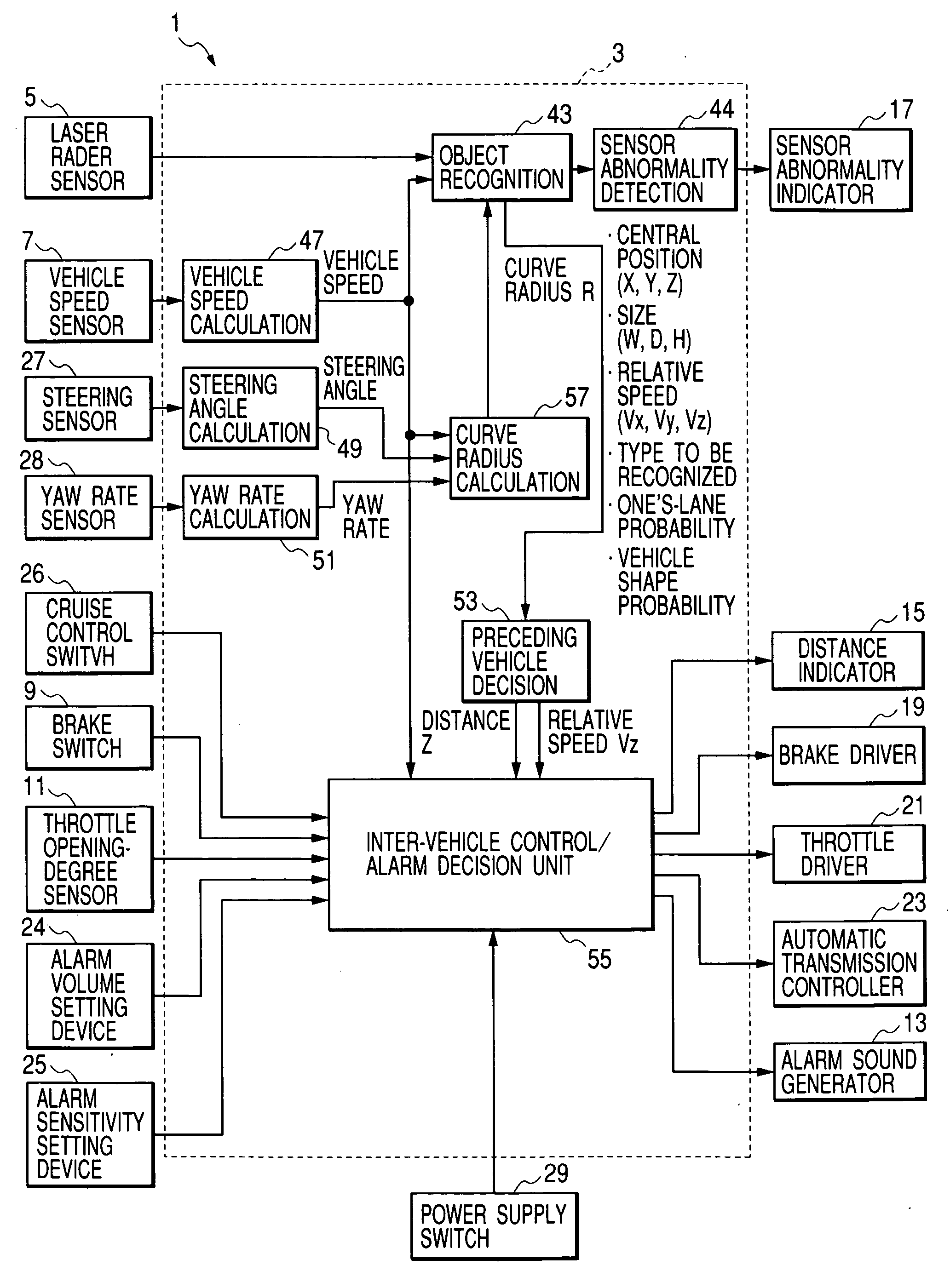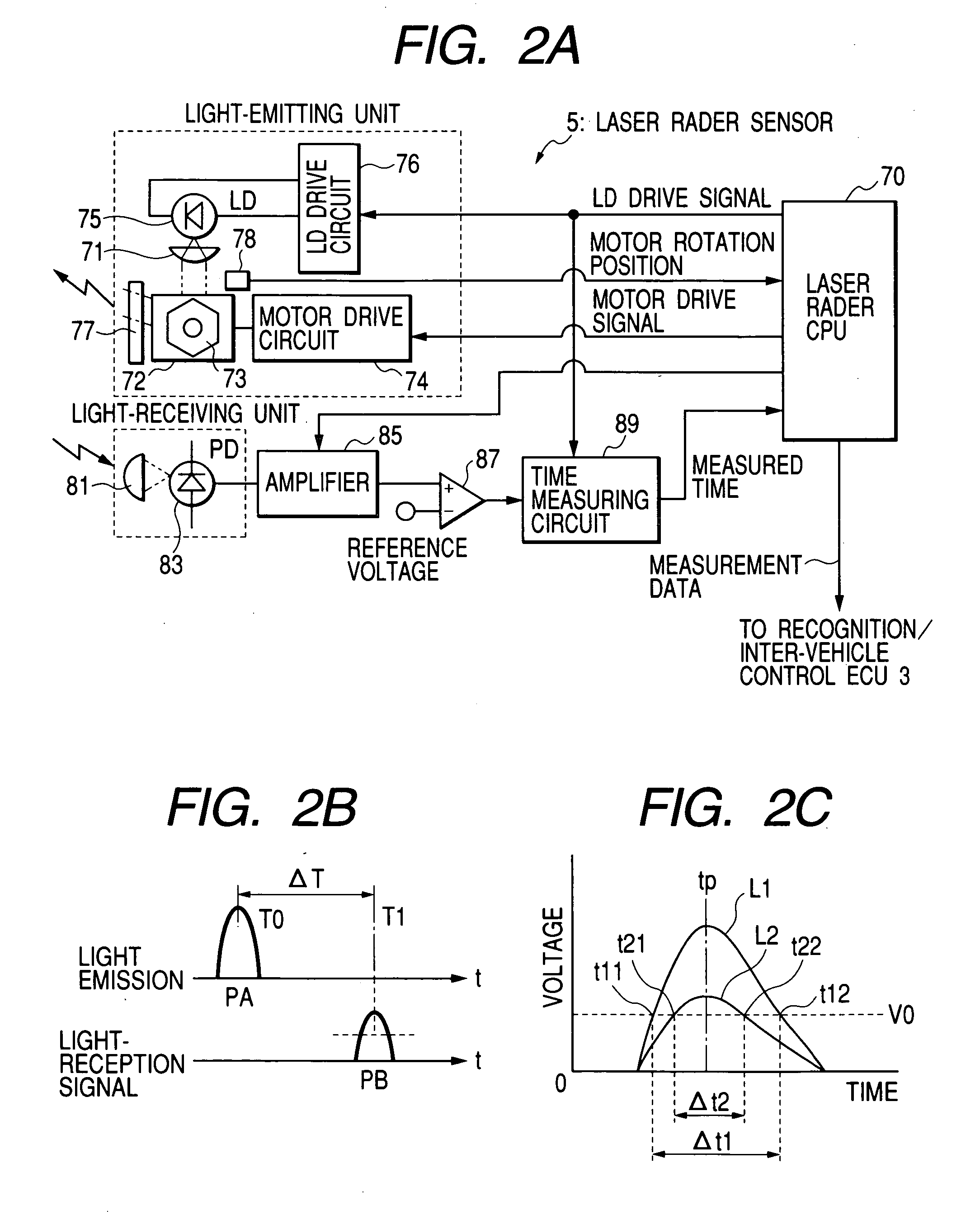Object recognition apparatus for vehicle, inter-vehicle control apparatus, and distance measurement apparatus
a technology of object recognition and vehicle body, which is applied in the direction of instruments, using reradiation, transportation and packaging, etc., can solve the problems of unstable detection of reflected light from the vehicle body, difficulty in high-accuracy vehicle recognition, and insufficient vehicle/non-vehicle security, etc., to achieve accurate distance detection
- Summary
- Abstract
- Description
- Claims
- Application Information
AI Technical Summary
Benefits of technology
Problems solved by technology
Method used
Image
Examples
first embodiment
(First Embodiment)
[0106] According to a first embodiment of the present invention, an inter-vehicle control apparatus is equipped with an object recognition apparatus for a vehicle, and the inter-vehicle control apparatus has a function to issue an alarm when an obstacle lies in an alarm zone.
[0107]FIG. 1 is a system block diagram showing the inter-vehicle control apparatus. In the illustration, the inter-vehicle control apparatus, generally designated at reference numeral 1, comprises a recognition / inter-vehicle control ECU 3 as a principal unit. The recognition / inter-vehicle control ECU 3 is composed of a microcomputer acting as a principal component, and is equipped with input / output interfaces (I / O) and various types of drive circuits and various types of detection circuits. This hardware configuration is of a general type, and the description thereof will be omitted for brevity.
[0108] The recognition / inter-vehicle control ECU 3 receives various detection signals from a laser ...
second embodiment
(Second Embodiment)
[0174] Referring to FIG. 5, a description will be given hereinbelow of processing on object recognition to be implemented in the object recognition block 43 of the recognition / inter-vehicle control ECU 3 according to a second embodiment of the present invention. FIG. 5 is a flow chart showing main processing for the object recognition according to the second embodiment of the present invention.
[0175] In FIG. 5, a step S210 is executed to read the measurement data for each scanning line from the laser radar sensor 5. In the laser radar sensor 5, the measurement cycle for three scanning lines is 100 msec.
[0176] A step S220 follows to delete the data showing a low light-reception intensity. That is, the measurement data includes a pulse width of a stop pulse PB representative of the light-reception intensity of a reflected wave, and the pulse width thereof is compared with a deletion reference value to remove the measurement data showing a pulse width below a prede...
third embodiment
(Third Embodiment)
[0215] A distance measurement apparatus according to a third embodiment of the present invention is also applicable to a vehicle control apparatus shown in FIG. 1.
[0216] First of all, referring to FIG. 12, a description will be given hereinbelow of a laser radar sensor 5 of a distance measurement apparatus according to the third embodiment of the present invention. In FIG. 12, the parts corresponding to those in FIG. 2A are marked with the same reference numerals.
[0217] In this embodiment, the laser sensor 5 successively performs the scanning within an area of approximately 7.8 degree in each of right- and left-side directions with respect to a center axis of a vehicle toward the forward direction of the vehicle. Concretely, the scanning is made from the left-side direction to the right-side direction, and 105 transmission laser beams whose horizontal beam numbers are 0 to 104 are emitted at an interval of 0.15 degree. That is, the horizontal beam number 0 corres...
PUM
 Login to View More
Login to View More Abstract
Description
Claims
Application Information
 Login to View More
Login to View More - R&D
- Intellectual Property
- Life Sciences
- Materials
- Tech Scout
- Unparalleled Data Quality
- Higher Quality Content
- 60% Fewer Hallucinations
Browse by: Latest US Patents, China's latest patents, Technical Efficacy Thesaurus, Application Domain, Technology Topic, Popular Technical Reports.
© 2025 PatSnap. All rights reserved.Legal|Privacy policy|Modern Slavery Act Transparency Statement|Sitemap|About US| Contact US: help@patsnap.com



